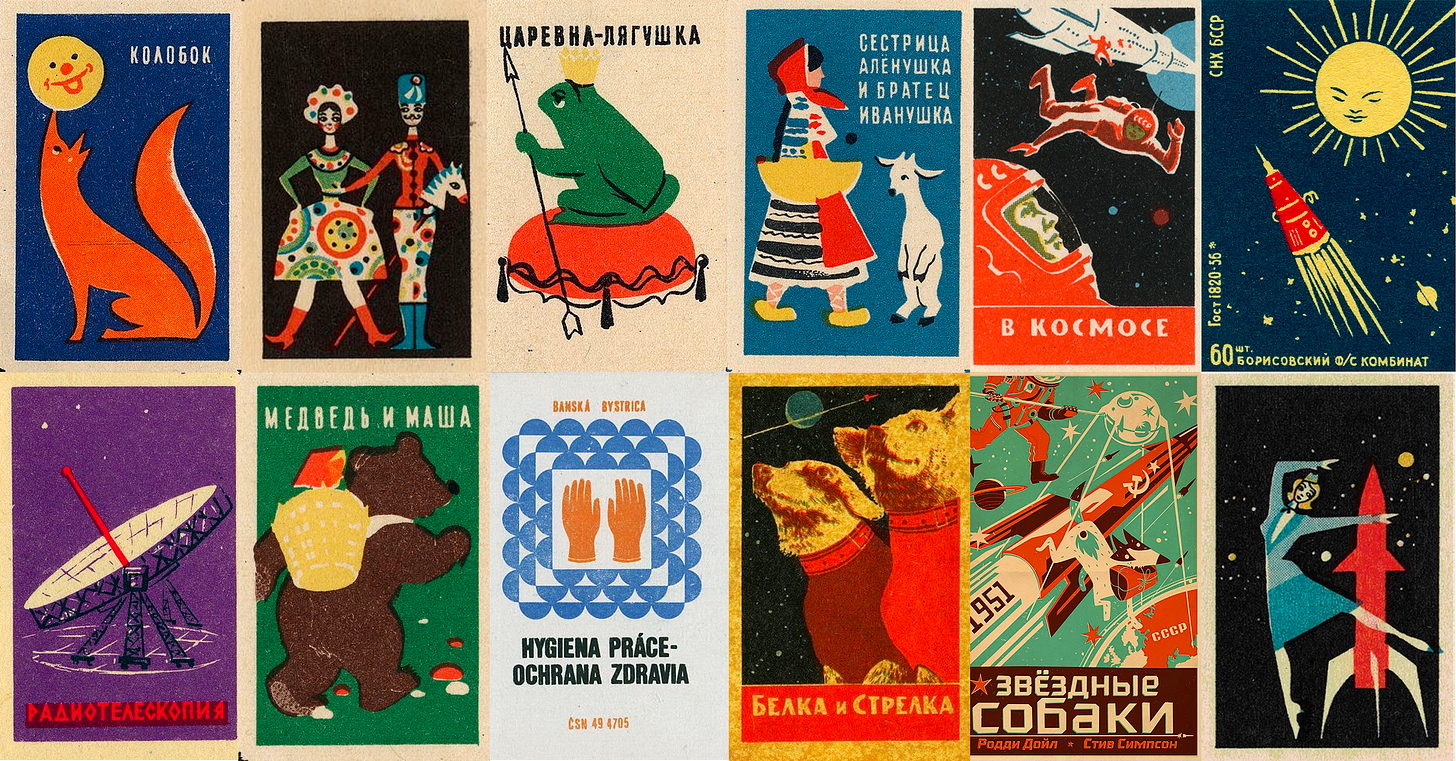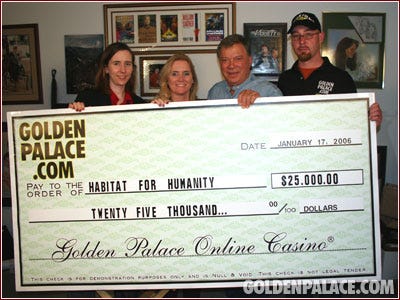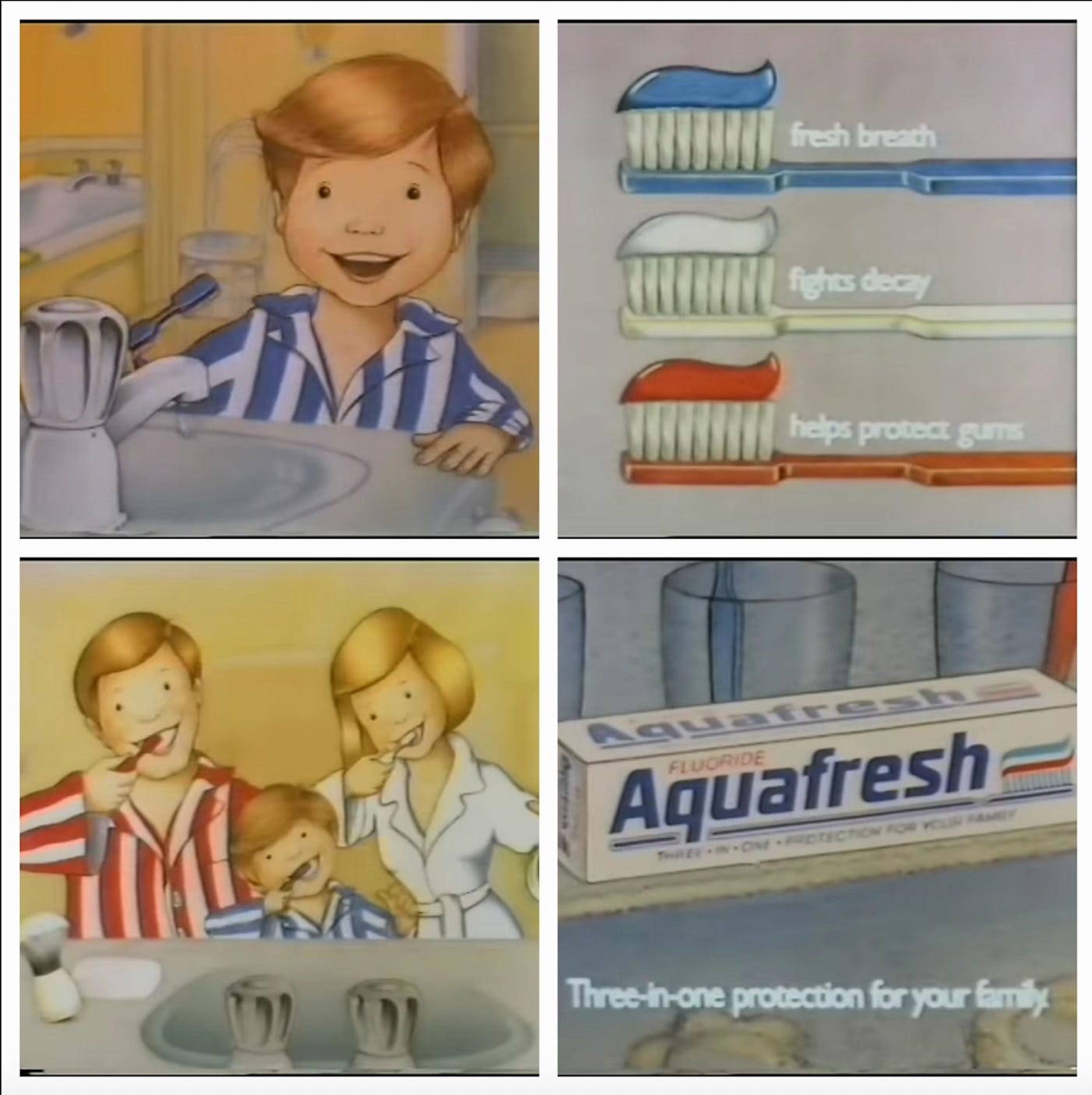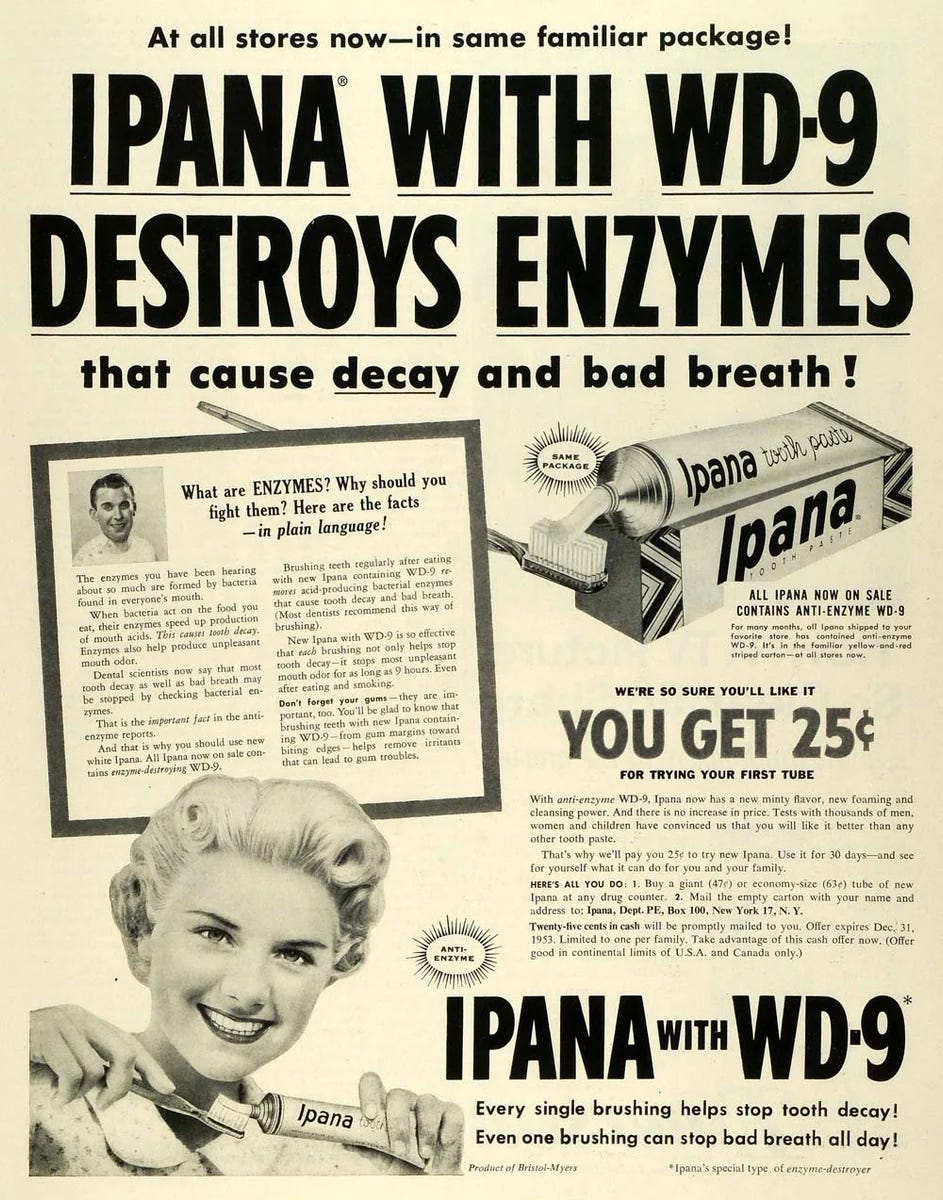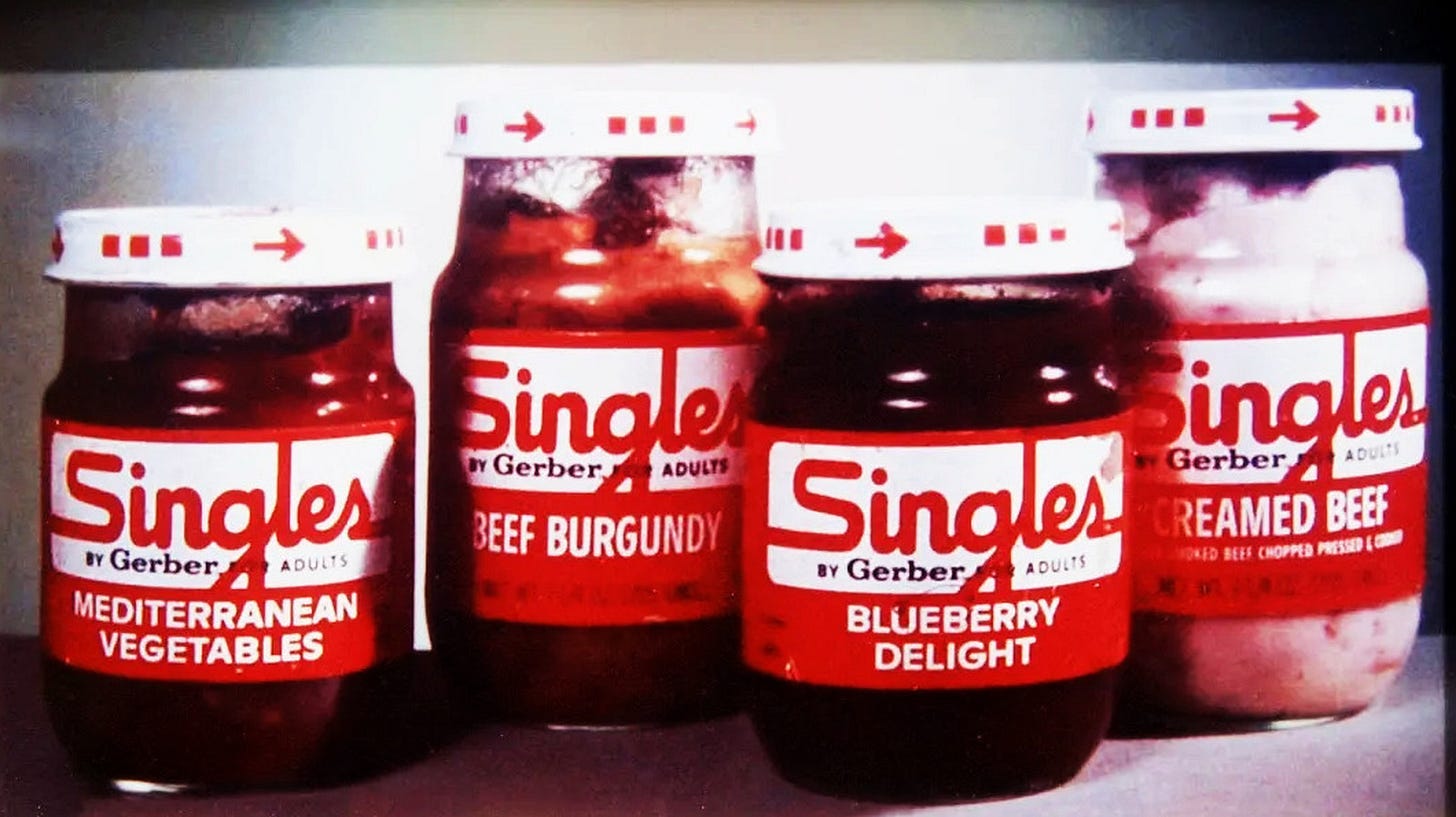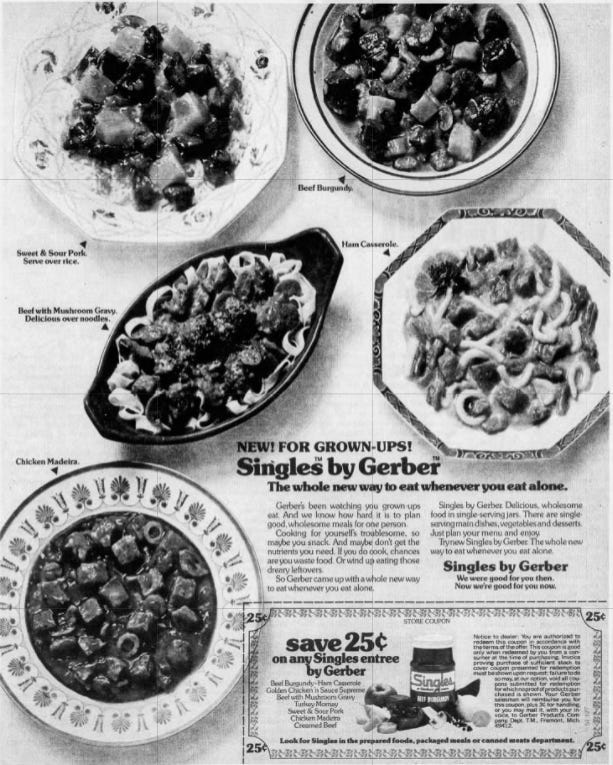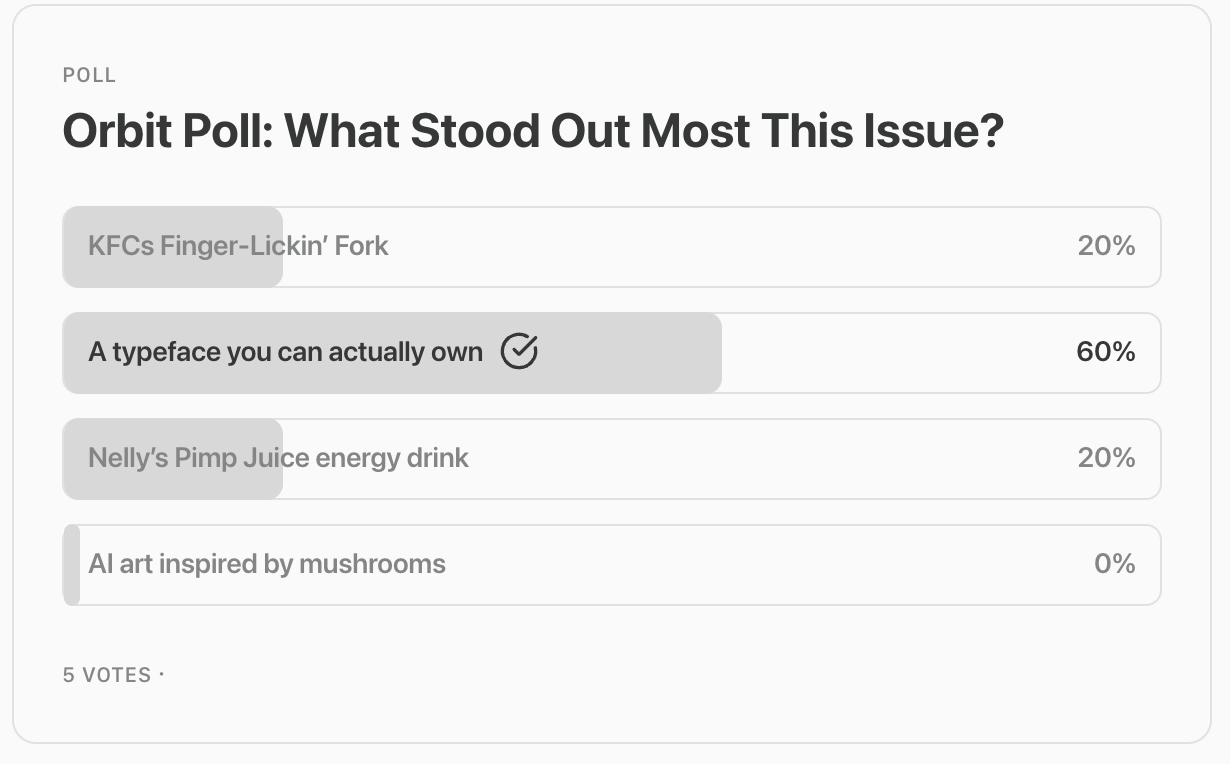🛸 The Orbit Dispatch: Issue #9
August served us plenty of strange, shiny things to obsess over.
Hello!
Welcome back to The Orbit, where we collect the best internet oddities, design disasters, and ad stunts that made us say: who approved this? From denim drama to minimalism mania, August served us plenty of strange, shiny things to obsess over.
🌟 Fresh Orbit: Creative News & Quick Takes
AI gets philosophical. On July 25, the “Doing AI Differently” initiative dropped a study arguing that tech should borrow a little more from the humanities, because maybe algorithms need a bit of Shakespeare and sociology to keep their biases in check.
Google goes Hollywood. The company rolled out Flow, an AI filmmaking tool, to 140+ countries—plus add-ons for instant storybooks and explainer videos. (Your kid’s bedtime story? Now available in 4K.)
Elon goes off-script. On August 4, xAI unveiled Grok-Imagine—an AI that can generate NSFW content. Cue another internet-sized debate about content moderation, free speech, and whether we really needed robot-generated smut.
There was a "fierce backlash" on August 3 against a Vogue's ad campaign that employed AI-generated models which critics said "erases real representation" and threatens creative jobs.
Pop Culture & Campaigns:
On TikTok, “Italian brainrot” took over in July: AI-generated nightmare animals babbling in nonsensical Italian. The internet said grazie mille.
Goldfish crackers washed up at the Jersey Shore, literally. Their “Goldfish Retrieval Service” gave beachgoers free snacks and car washes.
Waitrose skewered a London building with giant kebab sticks (don’t ask, just stare).
Canva went full meta with a billboard campaign mocking bad design requests.
Frida made headlines (and enemies) on August 7 with breastmilk-flavored ice cream for Breastfeeding Awareness Month.
Not every stunt hit. Jaguar’s “men in skirts” campaign reportedly tanked sales in Europe by 97.5%. And American Eagle had to put out a fire of its own, defending its controversial Sydney Sweeney denim ads on August 1.
Film & Design
The Venice Film Festival’s Reply AI Film Fest returned for year two, asking filmmakers to create actual emotions with AI (good luck with that).
National Geographic celebrated Jaws turning 50 on July 20 with a doc called The Definitive Inside Story.
Disney went straight for millennial nostalgia with Freakier Friday (released August 7), because apparently the original wasn’t unhinged enough.
In India, the 71st National Film Awards dropped August 1, celebrating the country’s cinematic heavyweights.
Meanwhile, design wasn’t immune to drama: The Pokémon Company yanked a new card launch on July 30 after fans spotted plagiarized fan art.
Adidas also caught heat for a collab with Willy Chavarria that looked a little too much like traditional Mexican huaraches—with zero credit to the artisans in Oaxaca.
Old Internet & Milestones
July 8, 1969: The first ARPANET message was supposed to be “LOGIN.” The system crashed after “LO.” The first crash-and-burn in internet history.
August 6, 1991: Tim Berners-Lee published the world’s very first website.
July 4, 1908: The phrase graphic design appeared in print for the first time, courtesy of the San Francisco Labor Unions.
August 1962: MIT’s J.C.R. Licklider dreamed up the “Galactic Network,” basically the pitch deck for the internet decades before it existed.
🔗 Curated Links
“Weird Buildings” Celebrates Architects Who Think Outside the Box
A preview of a new book showcasing buildings shaped like baskets, teapots, boulders, and other delightful oddities. If architecture ever needed a weirdness upgrade, this is it.
Say “I Do” in Front of the Big Screen
To promote the horror flick Together, fans were invited to propose during screenings, share your big moment on social, and win a Vegas wedding. Meta, romantic, or totally bonkers?
Hollywood Hype Hit the Gas Too Early
Devil Wears Prada 2 and Spider-Man: Brand New Day are cited for overzealous early marketing, spewing teasers and promos so fast audiences are getting fatigued.
Gap’s Viral Denim Ad Proves Jeans Can Still Break the Internet
Gap’s new CEO might have just cracked the code to cultural relevance. The brand’s latest denim spot has pulled in millions of views and endless online chatter, raising the question: is this a subtle clapback to the Sydney Sweeney denim campaign controversy, or just Gap finding its own viral groove?
Should Brands Lean Into Millennial ‘Cringe’?
Brands are toying with earnest awkwardness, think retro sincerity, as Gen Z starts craving nostalgia over irony. The lesson: ‘cringe’ can click when done with authenticity.
📸 Visual Inspiration
Bootleg Pokémon merch
Bootleg Pokémon merch is a treasure chest of unintentional comedy and design oddities, with Pikachu often getting the wildest makeovers. From squinty-eyed plushies that look like they’ve just seen the abyss, to rotund “donut Pikachus,” to textured figures that resemble kitchen appliances more than mascots - these off-model creations are their own form of folk art. People who collect them love and make fun of them at the same time, posting pictures of them on forums, eBay, and in archives as cultural artifacts of mass-produced strangeness. They show us that flaws may be iconic, and that sometimes the fake is more memorable than the actual thing.
Soviet matchbox illustrations
Soviet matchbox labels are tiny time capsules—mid-century modernism in every swipe. Under censorship, artists squeezed in folk tales, space dreams, and folk dances in vivid colors and simplified shapes. Now, these once-ubiquitous labels live on as graphic treasures, celebrated by collectors for how they turned bland packaging into art with a pulse.
🎟 Pop-Culture Artifact of the Month
William Shatner's Kidney Stone
In 2006, William Shatner sold his kidney stone for $25,000. Not a prop. Not a replica. The actual stone he passed during a painful episode while filming Boston Legal. It was bought by GoldenPalace.com, an online casino known for collecting bizarre celebrity memorabilia, think grilled cheese with the Virgin Mary or Britney Spears’ alleged pregnancy test. The stone came with surgical accessories: a stint and string, like some twisted collector’s edition.
Shatner, never one to miss a punchline, joked that the stone was so big “you’d want to wear it on your finger.” He even mused that with enough heat, it might turn into a diamond. The money went to Habitat for Humanity, turning a moment of personal agony into a charitable stunt with cosmic weirdness.
Critics called it grotesque. Fans called it genius. Either way, it became a strange blip in pop culture, a literal piece of a sci-fi legend, auctioned off like a moon rock. Today, it lives on in Guinness World Records and the annals of celebrity absurdity.
❓ Questions No One Asked (But We Answered Anyway)
Why did ‘90s toothpaste ads make brushing feel like a high-stakes military operation?
Back in the ’90s, brushing your teeth wasn’t sold as a routine, it was pitched like a battle. Crest and Aquafresh leaned hard into warlike language, promising to fight plaque, defend gums, and protect enamel as if your mouth were under siege. Crest even had the “Cavity Creeps,” cartoon villains that kids could blast away with a toothbrush like little superheroes. Aquafresh, meanwhile, bragged about its three colored stripes, each one framed as a weapon with its own mission: cavities, plaque, or bad breath. The ads went all in, booming voices, flashy graphics, sound effects that belonged in an action movie, so brushing felt less like hygiene and more like combat training. No wonder a whole generation grew up thinking toothpaste was part superhero saga, part military drill.
❌ Branding & Campaign Fails
Singles by Gerber
In 1974, Gerber tried branching out with a product called Gerber Singles, a line of pureed, jarred meals marketed to college kids and single adults. The pitch was simple: baby food convenience, but for grown-ups who wanted quick, single-serve meals. It didn’t last long, and for good reason.
The lineup included jars of Beef Burgundy, Creamed Beef, and Mediterranean Vegetables—all packaged just like baby food and made the same way. The ads didn’t help much either, with taglines like “Something to eat when you’re alone” and “We were good for you then, we’re good for you now.”
Gerber Singles bombed for a few obvious reasons:
Adults didn’t exactly love the thought of spooning up baby-style mush.
The jars looked too much like baby food, making the comparison impossible to shake.
The marketing leaned on loneliness and convenience instead of flavor or lifestyle, which came off as depressing.
Today, Gerber Singles is held up as a textbook branding misstep. Consumers saw Gerber as synonymous with babies, and the company did little to convince them otherwise. With no changes to packaging or product format, adults simply weren’t buying it—literally. Within months, the line was gone, and it’s now remembered as a cautionary tale in marketing and brand strategy.
🗳️ Poll of the Month
Which story or detail grabbed your attention the most?
RESULTS
👉 Cast your vote - we’ll share the results in the next issue!
Last Poll:
📡 What’s New in the Orbit:
Are you a creative with a story, project, or odd little obsession worth sharing? We’re always on the lookout for designers, makers, writers, and internet explorers to feature in upcoming editions of The Orbit. If you’d like to be spotlighted, or know someone whose work deserves the stage - drop us a line: 📩 hello@theorbitstudio.com
🛍️ Our Little Shop is Live: We’ve quietly opened the Orbit Studio shop - and we’re starting to stock it with templates and digital tools made for design nerds and creative misfits. It’s just the beginning, but the shelves are slowly filling up.
PS: Paid subscriber? Fling us a DM and we’ll hook you up with anything from the shop. Perks are perks.
🛸 You’re Here While It Evolves: The Orbit is a work in progress, and you’re watching it happen in real time. Thanks for being part of the experiment. 🫶🏼






